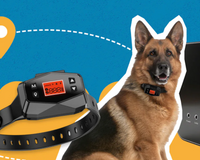Static Bark Collars- Myths Explained and Debunked
As dog owners, we all want the best for our dogs, and it's normal to be cautious about using a bark collar or dog training collar as part of your training. There are many reasons why dog owners use a training collar. Some feel they haven't seen the results they wanted from their training methods and need another option. Others use it because they know it can be a powerful tool to help teach their dog commands. Once you're introduced to the world of e-collars, they become an indispensable tool you'll be thankful to have.
What are bark collars? What are dog training collars?
Bark collars and dog training collars (also known as e-collars) are advanced pet training tools that gently but effectively redirect your dog's behaviour. By breaking down some myths around their use and effects, it becomes easier for you to decide if a bark collar is a training tool you're comfortable using.
E-Collars: NOT Your Outdated Shock Collars
Before we dive in, let's clarify bark collars. Understanding bark collars and what they do helps dog owners see the device as a valuable training tool. You've likely heard 'bark collars' or 'e-collars' referred to as 'shock collars'. However, shock collars have a history that makes them different from modern e-collars. Most older shock collars used electric shock treatment for behaviour modification, which gave dogs a shock. Modern e-collars, on the other hand, use Electronic Stimulation (ES) as a painless alert or distraction to redirect their energy.
How Do Bark Collars Work?
The bark collar aims to effectively distract and interrupt your dog from their current behaviour so you can direct their energy elsewhere. Your dog quickly learns that a distraction will occur if they bark excessively or behave unfavourably. Remember: these collars are a distraction tool, not a punishment device. They work best when combined with positive reinforcement training. Now that you're more comfortable with e-collars let's address some myths.
Myth 1: Static Collars Are Painful for Dogs
It's important to understand that static shocks differ from electric shocks. Both static shock and electric shock use the word "shock", but they are not the same. The distraction e-collars use is Electronic Stimulation. A static shock is no different from the "zap" you get when rubbing your feet on a carpet and touching something. It's unpleasant for a moment but not enough to hurt. Here's a comparison with other products using Electronic Stimulation:
- Muscle toning machines: roughly 2 joules on normal, up to 6 joules on high
- Electric security fence: roughly 3.2 joules
- An e-collar / training collar: roughly 0.000005 joules on low
The level of stimulation in an e-collar is minuscule. Even on the highest setting, it's not powerful enough to inflict pain on your dog. Some e-collars on the market don't use any form of shock. For example, a Citronella Collar uses a brief burst of non-toxic Citronella spray as the deterrent, effective because dogs dislike the scent! Many e-collars also come with an audible beep or vibration, and many have found success using these methods.

Myth 2: Static Collars Are Unsafe
Incorrect Usage Makes It Unsafe, Not The Collars! Like any training tool, e-collars can become unsafe when used incorrectly. Once you understand and implement proper usage, your e-collar is safe, non-painful, and works harmoniously with your training needs.
For safe static collar training, follow these guidelines:
1) Appropriate Duration of Wear
An e-collar should never be on for more than 8-10 hours at a time, and you should switch the collar's side every day to avoid pressure sores from the contact probes.

Like many dog owners, if you fear the collar is effective only if on 24/7, remember: initially, it has to be on more frequently to get your dog used to the training. Once they've learned to respond appropriately, you'll rarely need to use it! It then becomes a "maintenance" training tool.
2) Right Fit
The collar should sit high on the neck, ideally on either side of the throat. If it's too loose, it will slip and slide; if too tight, it will cause sores and irritation. It should fit snugly, but you should be able to put two fingers between the collar and your dog. Used incorrectly, the e-collar can become an unsafe and unpleasant experience. Used correctly, you'll see how responsive your dog becomes, even around distractions.
Myth 3: Static Collars Work Against Positive Reinforcement
e-Collars work best when combined with positive reinforcement! Think of training collars as reinforcement tools: understanding a "No" (negative reinforcement) helps dogs recognise when they're doing the right thing and deserve a reward (positive reinforcement). Professional trainers recommend e-collars to complement positive reinforcement. Treats can be given for following collar instructions. After all, which dog doesn’t like to be rewarded for a job well done? Negative reinforcement is also important as it gives your dog immediate feedback that they're not doing the right thing, something positive reinforcement alone cannot provide. You can learn more about why e-collars should be used with positive reinforcement here.
Myth 4: Not for Anxious & Fearful Dogs
We might think e-collars are scary and not effective for anxious dogs. When used correctly, an e-collar can help interrupt the anxious or fearful state of mind, redirecting their behaviour. Many owners have had their dogs eagerly sit in front of them, waiting for the collar, as they recognise it as a cue for outside play and exercise time - a treat for bored dogs!
What Now?
Remember, static collars are just one of many training tools. Neither positive reinforcement, a lead, nor an e-collar should be seen as the ultimate solution to training. As long as you're using them correctly and understand how they help your dog, e-collars can elevate the training goals you've set. There are also other Bark Collar options available, so you're bound to find one that suits your needs.
Disclaimer:
Remember, eDog UK and our staff are not professional dog trainers. We provide product advice and occasional educational tips to ensure a smoother, less stressful training experience for our customers or interested dog owners alike.











